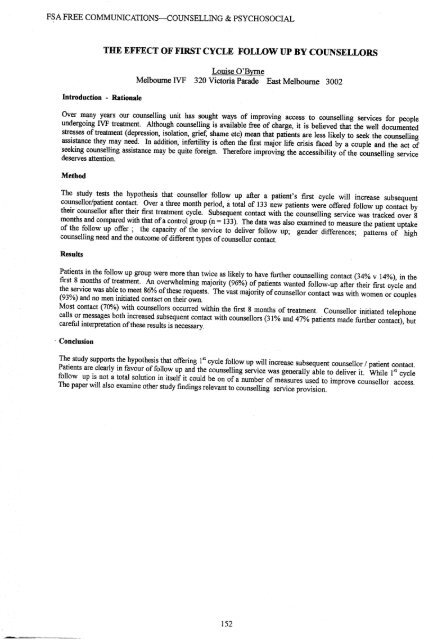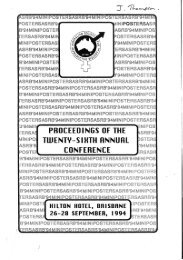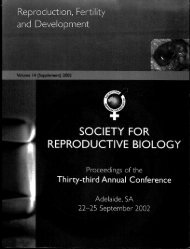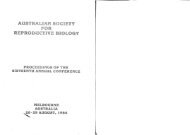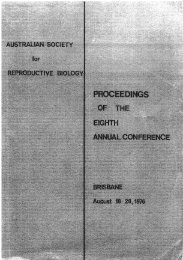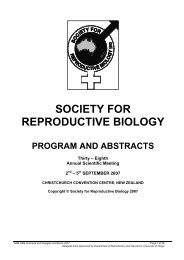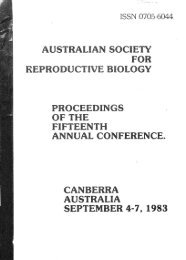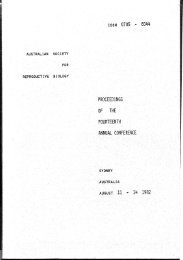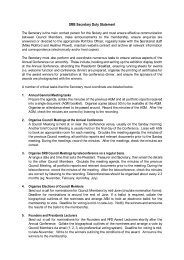ruoounu. nnSlunCIS&UINI-rOSIlnS - the Society for Reproductive ...
ruoounu. nnSlunCIS&UINI-rOSIlnS - the Society for Reproductive ...
ruoounu. nnSlunCIS&UINI-rOSIlnS - the Society for Reproductive ...
You also want an ePaper? Increase the reach of your titles
YUMPU automatically turns print PDFs into web optimized ePapers that Google loves.
F~A FREE COMMUNICATIONS-COUNSELLING & PSYCHOSOCIALFSA FREE COMMUNICATIONS-COUNSELLING & PSYCHOSOCIALIntroduction - RationaleTHE EFFECT OF FIRST CYCLE FOLLOW UP BY COUNSELLORSLouise O'BymeMelbourne IVF 320 Victoria Parade East Melbourne 3002Over m~ny years our counselling unit has sought ways of improving access to counselling services <strong>for</strong> peopleundergomg IVF treatment. Although counselling is available free of charge, it is believed that <strong>the</strong> well documentedstr~sses oftreatment (depression, i~~lati~n, ~~f, s?ame etc) mean that. patients are less likely to seek <strong>the</strong> counsellingass1~tance <strong>the</strong>y may need. In add1tion, mfertIhty 1S often <strong>the</strong> first major life crisis faced by a couple and <strong>the</strong> act ofseekmg couns~lling assistance may be quite <strong>for</strong>eign. There<strong>for</strong>e improving <strong>the</strong> accessibility of<strong>the</strong> counselling servicedeserves attentlOn.MethodThe study te~ts <strong>the</strong> hypo<strong>the</strong>sis that counsellor follow up after a patient's first cycle will increase subsequentco~sellor/pat1ent contaC!. Over a three month period, a total of 133 new patients were offered follow up contact by<strong>the</strong>1r counsellor after <strong>the</strong>Ir first treatment cycle. Subsequent contact with <strong>the</strong> counselling service was tracked over 8months and compared with that ofa ~ontrol group (~= 133). ~he data was also examined to measure <strong>the</strong> patient uptakeof <strong>the</strong> f~llow up offer; <strong>the</strong> capaCIty of <strong>the</strong> servIce to delIver follow up; gender differences; patterns of highcounsellmg need and <strong>the</strong> outcome ofdifferent types ofcounsellor contact.ResultsPatients in <strong>the</strong> follow up group were more t~an twi~e .as likely to have fur<strong>the</strong>r counselling contact (34% v 14%), in <strong>the</strong>first 8 ~onths oftreatment. An overwhelmmg maJonty (96%) of patients wanted follow-up after <strong>the</strong>ir first cycle and<strong>the</strong>:efVIce was abl~ t.o. meet 86% of<strong>the</strong>se requests. The vast majority ofcounsellor contact was with women or couples(93 %) and no men InItIated contact on <strong>the</strong>ir own.Most contact (7()oJO) ~th counsellors occurred within <strong>the</strong> first 8 months of treatment. Counsellor initiated telephonecalls or.messages ~oth mcreased subsequent contact with counsellors (31% and 47% patients made fur<strong>the</strong>r contact), butcareful mterpretatlOn of<strong>the</strong>se results is necessary.. ConclusionTh~ study supports !he hypo<strong>the</strong>sis that offering 1st cycle follow up will increase subsequent counsellor / patient contact.PatIents are. clearly m favour offollow up and <strong>the</strong> counselling service was generally able to deliver it. While 1st cyclefollow up I~ not a total ~olution in itself it ~ould be on of a number of measures used to improve counsellor access.The paper wIll also examme o<strong>the</strong>r study findmgs relevant to counselling service provision.SELF-CONCEPT DISCREPANCY THEORY: A MODEL FOR UNDERSTANDINGINDIVIDUAL VARIABILITY IN REACTIONS TO INFERTILITY.Meredith 1. Krust-McKay<strong>Reproductive</strong> Medicine Unit, The Queen Elizabeth Hospital and Wakefield Clinic, University ofAdelaide,Adelaide, SA, 5000.Purpose: Empirical investigation of <strong>the</strong> psychological sequelae of infertility has so far produced an inconsi,stentcharacterisation of <strong>the</strong> emotional demands of this experience. It has been suggested that such inconsistencies mayreflect individual variability in <strong>the</strong> response to infertility, which few studies have considered to date. This resea.iChinvestigated Higgins' (1987) Self-Discrepancy Theory (SDT) as a conceptual alternative <strong>for</strong> understanding individ~variability in psychological reactions to infertility. Higgins' <strong>the</strong>ory proposes that people possess more thanone~nPe,~tof <strong>the</strong>mselves and that discrepancies between <strong>the</strong>se self-concepts results in ei<strong>the</strong>r dejection or agitation relatedemotional discom<strong>for</strong>t. SDT is <strong>the</strong>re<strong>for</strong>e proposed as a model <strong>for</strong> understanding <strong>the</strong> type and magnitude of emotionalreactions a person may experience, based upon <strong>the</strong> type and magnitude ofself-concept discrepancies.Aims: The research aimed to (a) validate <strong>the</strong> application ofSDT to <strong>the</strong> problem ofinfertility and (b) draw conclusionsabout <strong>the</strong> clinical utility ofSDT as a model <strong>for</strong> predicting <strong>the</strong> type and magnitude ofindividual emotional responses toinfertility.Method: Participants were 20 male and 26 female fertility patients, diagnosed with primary and secondary infertility.Participants completed a postal questionnaire containing self-report measures ofdepression, anxiety, psychologicalsymptomatology, and self-concept discrepancy.Results: The results ofthis research indicate that people with fertility problems do experience discrepancies between<strong>the</strong> different self-concepts proposed by SDT. Correlational analyses revealed that as <strong>the</strong> magnitude ofself-conceptdiscrepancies increased levels ofemotional discom<strong>for</strong>t also increased (r's ranged from.32 to .41, p


